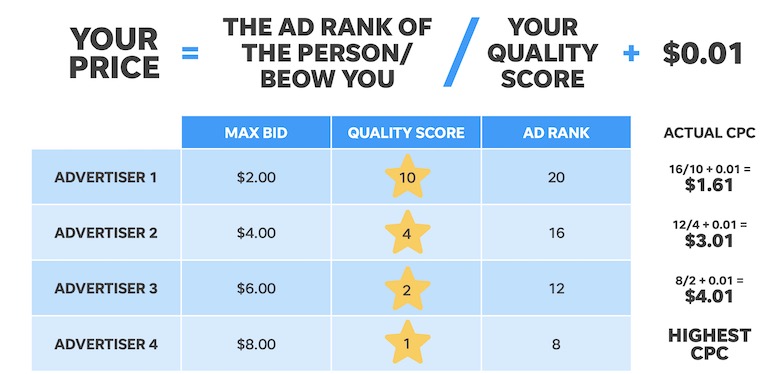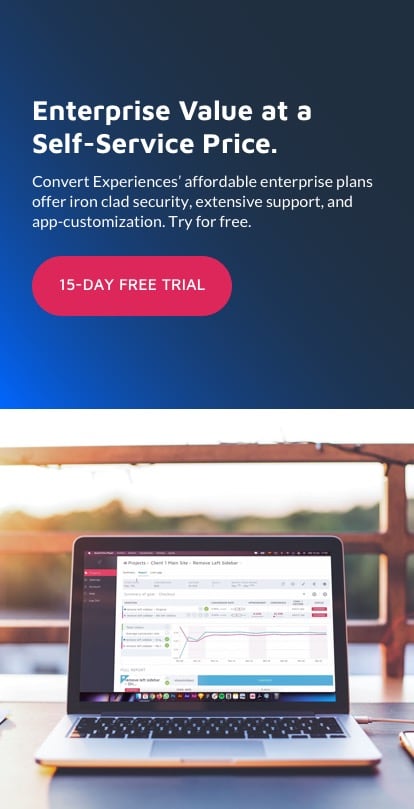How To Successfully A/B Test with Google Ads Traffic. UTM Parameters, Targeting & More.
Has this ever happened to you?
You’re running an A/B test on your site and you are in a dilemma around audience targeting and segmentation. Should you expose expensive paid traffic to a variant that may actually be worse than the control?
Of course in all A/B tests, there is an opportunity cost involved. Basically, you are betting on one of your page versions being significantly poorer in terms of driving desired actions than the other.
Hopefully though, it’s the control (original) that takes a beating.
But the soft “loss” of denied conversions hurts even more when the traffic in question is paid since you have well… spent actual money for the traffic. In particular, if your PPC is Google Ads.
Keep This in Mind Before Funneling Google Adwords Traffic to A/B Tests
Google Ads traffic is poised for conversions. Here’s why.
Google Ads has purportedly leveled the playing field for advertisers with smaller budgets.
How does it manage this?
It puts the Quality Score (QS) of its ads at the heart of its Ad ranking and bidding system. Quality Score comes into play twice in determining your CPC and takes into account:
- The Click Through Rate (CTR) the ad has seen/is seeing
- The relevance of the keywords in the ad group
- The legacy performance of your Adwords Account (you are rewarded for being an advertiser who consistently strives to provide a pleasant user experience that ends in a search result the querent finds useful)
- The subjective quality of the text and the destination landing page (Google uses its engagement signals of bounce rate and dwell time to decipher the “quality” of and coupling between the ad and the destination.)
Google calculates the Ad Rank of your submitted ad by multiplying the Quality Score with your maximum Cost Per Click bid.
But this isn’t what you pay for each click. What you do end up paying is actually the Ad Rank of the Account That’s Below You divided by your Quality Score, plus a cent more.
In short, your Quality Score gives your Ad rank an edge. And then your Quality Score further reduces what you pay for each click.
Your budget is important. But you fight it out based on how well you get the intention behind the queries of your traffic and serve content to satisfy that.
So what are the risks of running an A/B test with Google Ads traffic?
When you send a Google Adwords click to an A/B test, you are directing a high intent, hard-won lead Google has gauged to be a good fit for conversions on your site to a potentially suboptimal experience (if your variant can’t beat the control).
Also, if everything we have discussed is true, then an external validity threat, like a flickering issue, or lack of proper test QA before deployment, carries the threat of not just skewing your test data, but also impacting the performance track-record of your entire Adwords account!
Read on to find out how you can mitigate that risk and test well with traffic coming from Google Ads.
Optimizers Ask Convert Support Agents These Two Things About Testing with Google Ads Traffic
QUERY SAMPLE #1
QUERY SAMPLE #2
Basically, they wish to either:
- Exclude Ads traffic from their A/B tests and experiences, or
- Ensure that tests specifically designed for paid traffic can attribute behavior and conversions to Google Ads.
This covers all the concerns we’ve discussed so far.
Excluding Ads traffic successfully cuts down the opportunity cost and the loss of dollars invested in acquiring clicks.
Creating a test meant for Ads traffic at least implies that the marketing team is more focused on the context of PPC and thus aware of the trade-off involved in testing — lost ad budget and a loss in Quality Score of the ads and even the entire account IF test QA is taken lightly.
The Solution to Testing Well with Google Ads Traffic
There are three parts to achieving successful A/B testing with Adwords traffic:
- Properly using Google Ads UTM tags (+ should you pick Manual or Automatic tagging?)
- Leveraging Convert Experiences’ flexible advanced targeting engine.
- Accurately attribute behavior using Convert Experiences’ persistently stored source data.
#1: Proper Use of Google Ads UTM Tagging
UTM parameters are the most common form of link/ad tracking. You either manually add UTM parameters like utm_campaign, utm_medium, and utm_source to all of your outbound URLs, or you use a utm link builder tool to help you do this.
With Google Ads, there’s a shortcut: Auto-tagging.
Auto-tagging automatically tags URLs in all of your campaigns. It also gives you access to analytics data that is otherwise impossible to obtain through regular UTMs.
So to summarize, auto-tagging saves you the time and effort of manually tagging URLs, makes the whole process almost completely error-free, provides more detailed analytics, pushes all the data automatically to Google Analytics, and is available at the click of a button.
The downside is the Auto-tagging feature is completely tied into Google’s ecosystem and only works with Google Analytics.
So if you want to use it with a platform like Convert Experiences that parses and reads UTMs, you won’t be able to do so.
The reason is that when you enable auto-tagging, a “GCLID” parameter is passed at the end of the URL. Anything after the “=” sign is your tracking data, but encrypted. Only Google Analytics can actually translate this and have it show up as human-readable analytics data in your dashboard.
This is where manual Google Ads UTM tagging comes in handy.
Especially if you are interested in getting granular and targeting traffic from particular campaigns, instead of just eliminating everyone who has come into the test environment through an Ads campaign which is possible by targeting the GCLID parameter itself.
#2: The Convenience of an Advanced Targeting Engine
The drag and drop advanced targeting engine is the crown jewel of Convert Experiences.
It allows users to stack 40+ conditions to create incredibly complex yet precisely segmented audiences that are exposed to specific A/B tests to ensure the best possible statistical probability of any desired behavior detected during the tests to roll out across the entire site, for a larger sample size of the same audience.
Use this advanced targeting engine when running multiple Ads campaigns and multiple A/B tests to send or block traffic to the intended variants by targeting the UTM parameters.
It gives you a better shot at eliminating a negative impact on paid traffic because of random occurrences or oversight, reducing the risk of throwing off the Quality Scores.
#3: The Ability to Persistently Attribute Behavior to Ads Traffic
It’s not enough to simply target Google Ads traffic. Data accuracy post results play a key role in A/B testing.
In case a funnel has been built to optimize conversions for Google Ads traffic — which is the main source of traffic and revenue for a myriad of publishing sites and affiliates — Convert Experiences has a convenient solution to improve attribution accuracy.
It can store the session “source” data persistently in a cookie, which can then be leveraged by the script to trigger the A/B test in the right site area or on the right funnel page for Ads traffic, even if that page is not the same as the landing page.
Two things happen as a result:
- You DON’T have to trigger the test on the landing page. You can maintain the integrity of your hypothesis and fashion the experiment in a way you know can incentivize the most conversions.
- Persistent source tracking attributes behavior and goals to the right channel, even in complex set-ups with multiple pages in the test funnel. If you are going to send high intent Ads traffic to A/B tests, you should at least be able to rely on what the numbers tell you, once the test has concluded.
Ready to run tests with Google Ads traffic?
If you like the flexibility of Convert Experiences, give our free trial a shot. We have features that minimize ad budget waste and attribution challenges.
Written By
Trina Moitra

Edited By
Carmen Apostu





